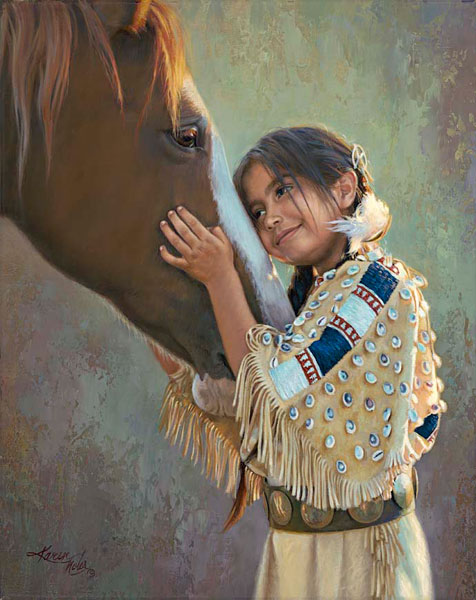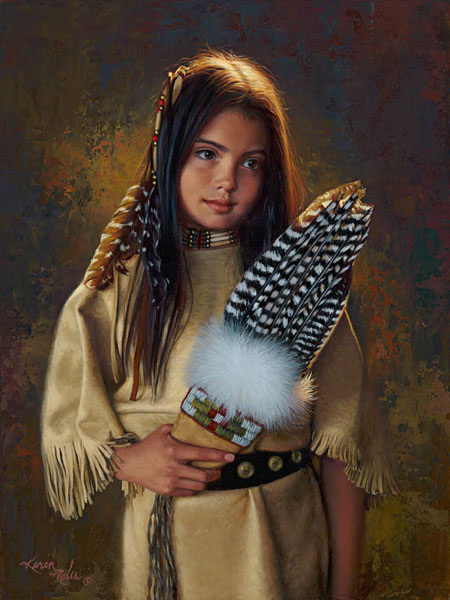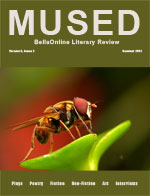Karen Noles
Lisa Shea
Tell us how you found your home on the Flathead Indian Reservation?
I was working full time with a greeting card company in Anaheim CA while my husband was going to college full time. When he finished with his education, our goal was to move somewhere in the northwest to a small community in a mountainous area where we could raise our family and I could have my own horse ( a life long dream). We met a young couple visiting the church we attended at the time that were from Polson which is on the Flathead Reservation. They described the area as the kind of beautiful rural area we were interested in living and invited my husband to come to Polson where he could stay with them while he checked out the job opportunities. He took them up on that invitation and consequently was offered 3 jobs in the first two days…one which was the teaching position in the high school. He came back to California with the exciting news and he moved the three of us…me and my 4 month old baby girl being the 3rd member of the family to Polson. I continued with a contract and freelancing in the illustration field for more than ten years before I began making paintings of Native American subjects. When we moved here I had no idea that I would one day be painting portraits of Native American subjects. It is interesting how destiny may have a plan for our life that we fall into by design. Or is it a trial and error process? These are questions I do contemplate.
 What draws you to portraying Native Americans of pre-reservation and early reservation time periods?
What draws you to portraying Native Americans of pre-reservation and early reservation time periods?
After tiring of the illustration work I began to pursue the fine arts, experimenting with different media and searching for a new subject matter that held a consistent demand in the market place. My interest was sparked once I realized the potential of the Western Art Market, its illustrious history of the American Cowboy and Indian and how much potential and inspiration this very place I lived in held for me. Once I began researching and photographing museum collections, talking with knowledgeable collectors of Western art and Native American collectibles I was hooked. I was especially drawn to the early and pre-reservation period clothing and artifacts in part due to the incredibly fine workmanship and artistry in color and design which they accomplished under primitive conditions and with simple and rather primitive tools. I found their use of the beads, cloth, ribbons, thimbles, coins and many other items that they traded for with the Europeans to be so very creative and unique and beautiful. I have found that the subject matter within this genre challenges my abilities to render life like, sensitive and emotional portraiture, the textures of buckskin, feathers and fur, as well as the fascinating, exquisite bead and quill work that was used to decorate their clothing, everyday items and other regalia. It gives me the opportunity to honor their artistic expression while I portray them in my own works of art. Within this subject matter I can pull landscapes into the backgrounds, incorporate wildlife or baskets and pottery. These options add variety and different approaches to planning compositions.
Many of your images show connections between Native Americans and horses, foxes, and cats. Can you talk about why the combination of human and nature feels so powerful to you?
I truly believe that... "relationship"... as "we" humans exist on this planet, is our highest calling. By that I mean that we are challenged to embrace, love, appreciate, respect and enjoy the diversity of all of creation. This universe is abundant with beauty and love. I relish the opportunity to make that emotional connection with animals and to portray that emotion in my paintings to remind us of this common spirit we share with all of creation. I see that making that connection is as valuable as seen in our relationships with our modern day pets as it was long ago with the wildlife that the Native Americans encountered and befriended. And it might be argued that much of the wildlife in those days was consumed as food, which is true, but there were times they became pets. The Native American ideal gave thanks and honor and respect to those animals that gave up their lives for their sustenance and survival. I have had a passion for horses since I was five and have owned and ridden extensively for over 30 years. Cats have been a part of my life as well. I had a friend that lived in the Swan Mountains that took in and cared for injured and abandoned wild animals and returned them to the wild. The young fox she bottle fed were just like little puppies. My models cuddled and played with them while I photographed the experiences for reference for my paintings.
How do you choose which outfit you wish to feature for a given image?
I have been greatly blessed by the friendship of a couple of kind and generous friends who have been collecting museum quality Native American artifacts for many years who share their collection with me by letting me bring select models to their Indian Room for photo shoots. There I dress them up in these authentic old beaded buckskin dresses and choose other items to work with the setting I am looking to create for a painting. I also photograph museum collections at every opportunity and purchase many books for reference when I need to change a dress or other item to Cheyenne rather than Sioux, etc. I have also had a few dresses made for my models to wear. I may have them hold, say a teddy bear I have...Then, with reference books etc… change that toy into a beautiful old Indian doll. Sometimes I may plan my painting around one beautiful dress… or if I want to portray a Blackfeet lodge setting I use these kinds of resources to compose a historically correct painting.
 I love the crafts you feature in several of the images. Can you talk a bit about how you choose which to show?
I love the crafts you feature in several of the images. Can you talk a bit about how you choose which to show?
I have exercised the "artistic license" somewhat by using some Southwest Indian pot or Coastal Indian basket with a Plains or Plateau subject in a painting. The Native Americans did trade with other tribes as well as the Europeans. As an example, you will find cowry shells decorating a Plains Indian dress that they traded for with the coastal tribes. The gracious friends that share their collections with me have these items in their collections… they are beautiful. I want to paint them. I admire the beauty and diversity of artistic expression within the many various tribes all over America so I create ways to illustrate that in my paintings. There are other times I make every effort to portray a Blackfeet girl with clothing and everything else in the painting be "Blackfeet". I put things together that work to make a beautiful statement with these ideals in mind.
You show women in all stages of life - young girls, mothers, and matriarchs. How do you approach each group, to bring out their beauty?
I love painting children because of their fleeting innocence, along with their genuine honest and spontaneous response to life. As a woman and mother of two girls I seem to relate most easily to girls and female subjects and the mother-child relationship is one I most cherish. I believe we all are created with the loving divine energy of the universe. It is most apparent and easily felt in young children because "life" has not diluted that spirit with the self consciousness, cares of the world and human earthly experience. My goal is to capture the divine spirit that lies within the individual that is pure and good and beautiful. I choose to see and feel and to bring to my canvas the dignity and the best of humanity. I had a wonderful mother and grandmother that taught me good values and I looked up to them. They inspired me to do and be my own personal best… to be authentic and true to myself. I look for and find that higher energy in my subjects… I paint what I see and feel. I see love and beauty in my models.
A few of the images incorporate outside influences, such as the lace umbrella or wagon wheel. Can you talk about the balance you strike there?
The American Indian was fascinated by many of the new things introduced to them by the culture of the Europeans. They loved the parasols or umbrellas and early pictures were taken by the photographers of the 1800s of even the braves riding horseback with a parasol in hand. The one painting of mine titled EMERGENCE depicting the young girl emerging from a girl into womanhood and standing by the wagon wheel illustrates this. The rich burgundy velvet material her dress was made from came from the Europeans and the cowrie shells decorating it came from the coastal tribes. We have always been interdependent. We need each other. We need to respect one another. People and cultures are always in a process of change and evolution and sharing. The Indian nations were influenced by each other and often took on some traits or ideas from one another.
 I love the details of the cowrie shells, the beading, the fringe. Do you have certain textures or combinations that draw you?
I love the details of the cowrie shells, the beading, the fringe. Do you have certain textures or combinations that draw you?
The creator has provided us with an incredible amount of visual stimulus that is beautiful and exciting, and as an artist, challenging to portray. When I look closely and intently observe an object and attempt to render that thing with paint onto a flat surface to make it look real, like it belongs there… a kind of meditation takes place where I go deeper into that thing… almost feeling and becoming one with it. Painting these things requires one to look and feel deeper into it than the casual glance most of us make. The Native Americans saw this beauty in nature and decorated their clothing with shells and feathers etc. Many of these things also had spiritual significance and were believed to bring them the strength, courage and power from the creature they came from. Everything has energy. There is an energy for good… that is the energy I choose to tap into and portray in my work.
I'm not quite sure how to phrase this next question, so I apologize if it doesn't come out properly. I adore the Native American culture and think the world could use more of their mindset, to preserve our world for future generations and to live in harmony with the world around us. Do you feel there's a way, by distributing these beautiful works of art, that the culture can spread too? Maybe can viewers touch a small portion of the serenity and connection with nature, and draw it into their own world?
It is my belief that if we are to survive and flourish ….we must learn to live in harmony with the world around us. I believe the creator put us here to love and be loved. I strive to infuse into my work, a sense of beauty and peace….the knowledge that we are all interconnected with everything in the universe…to be kind, harmonious, peaceful and respectful of the earth and its resources as well as all living things. I have chosen to make paintings which depict special or "sacred" moments in time, where the subject is in perfect harmony with nature. I create images that inspire strength, wisdom, tenderness, and innocence. They are visions that inspire me, give me pleasure and renew my spirit. I endeavor to make my experiences "stand still in time," hopeful that viewers will be taken to that same time and place and will be inspired to look for and savor those "sacred" moments in their own personal lives.
We'd love to hear anything else you'd like to share about your artwork and your hopes with sharing it.
Elevating the human spirit. There are so many ways to accomplish this. Everyone has their own unique gift. I am grateful if my paintings, in some small way, can accomplish this goal. I love to see and experience all that is good and beautiful; to paint the image and the emotion "masterfully," is an infinite and rewarding challenge.

